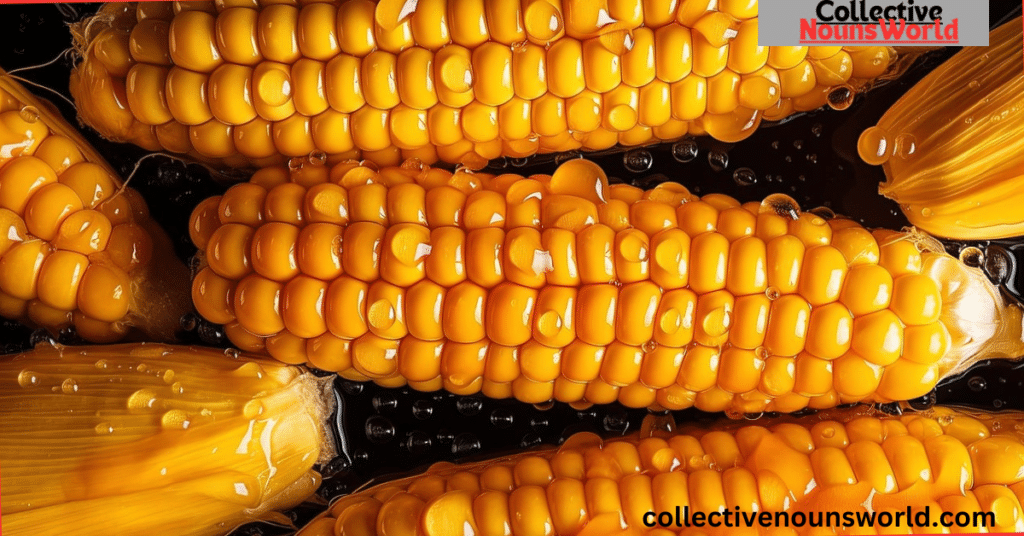In the vast landscape of agricultural terminology, few topics are as rich and varied as the collective nouns for corn. This golden grain, a staple in diets and economies worldwide, has inspired a plethora of terms to describe its groupings.
Whether you’re a farmer, a foodie, or simply curious about language, understanding these collective nouns offers insight into the cultural, historical, and practical aspects of corn cultivation and use.
The Language of Abundance
Corn, with its towering stalks and nutrient-rich kernels, stands as a symbol of agricultural abundance. As one of the world’s most widely cultivated crops, corn plays a crucial role in global food security, animal feed, and even industrial applications. In 2021, global corn production reached a staggering 1.2 billion metric tons, underscoring its significance in modern agriculture.
But why do collective nouns matter in agricultural terminology? These specialized terms not only facilitate precise communication among farmers, traders, and researchers but also reflect the rich history and cultural significance of corn across different societies.
The Primary Collective Noun: Shock of Corn
When discussing collective nouns for corn, the term “shock” often takes center stage.
Definition and Origin of “Shock”
A shock of corn refers to a bundle of corn stalks cut and stood upright in a field to dry. This term has deep roots in agricultural history, dating back to a time when harvesting was done entirely by hand.
“The golden shocks of corn stood like sentinels in the autumn field, a testament to the farmer’s labor and nature’s bounty.” – Unknown farm poet
Historical Context and Traditional Harvesting Methods
Before the advent of modern machinery, farmers would cut corn stalks by hand and gather them into upright bundles. This method served several purposes:
- Facilitated drying of the corn and stalks
- Protected the harvest from ground moisture
- Made later collection and transport easier
Case Study: Amish Corn Harvesting The Amish community in Lancaster County, Pennsylvania, still employs traditional methods of corn harvesting. They continue to create shocks of corn by hand, maintaining a connection to agricultural practices that have largely disappeared from modern farms.
Learn more about What is the Collective Noun for Vehicles?
Modern Usage and Relevance
While mechanized harvesting has largely replaced the need for shocking corn, the term persists in agricultural vocabulary and rural imagery. Today, you might encounter shocks of corn:
- As decorative elements in autumn festivals
- In educational displays about historical farming practices
- In artisanal or small-scale organic farming operations
Alternative Collective Nouns for Corn
While “shock” may be the most recognized collective noun for corn, several other terms describe corn groupings in various contexts.
Field of Corn: The Growing Perspective
A field of corn represents the most common sight in corn-growing regions. This term encompasses:
- Vast expanses of corn plants in various growth stages
- The entire ecosystem of a cornfield, including soil, insects, and other flora
Corn Field Facts:
- The average U.S. corn field is about 185 acres
- A single acre of corn can produce up to 15,000 pounds of silage
Bushel of Corn: A Measure Becomes a Collective
Originally a unit of dry volume, “bushel” has evolved into a collective noun for corn, especially in trade and commerce.
- 1 bushel of shelled corn = approximately 56 pounds
- Global corn trade often quoted in millions of bushels
Ear of Corn: When Parts Represent the Whole
An ear of corn typically refers to the entire cob with its kernels. However, it’s sometimes used collectively:
- “The farmer brought in a wagonload of ears”
- In culinary contexts: “We need a dozen ears for the barbecue”
Corn Collective Nouns in Different Contexts
The versatility of corn is reflected in the variety of collective nouns used across different sectors.
Agricultural Terms
Stand of Corn: From Seed to Stalk
A stand of corn refers to the density and health of corn plants in a field. Farmers use this term to assess crop quality and yield potential.
Factors Affecting Corn Stand Quality:
- Planting depth and spacing
- Soil conditions and fertility
- Pest and disease pressure
Crop of Corn: The Farmer’s Perspective
“Crop” serves as both a collective noun and a general term for the entire corn growing cycle.
- “This year’s corn crop looks promising”
- Used in yield estimates: “A crop of 200 bushels per acre”
Culinary Applications
Cob of Corn: On the Plate
In culinary contexts, a cob of corn often becomes the collective unit:
- “We’re grilling a dozen cobs for dinner”
- Recipe instructions: “Add 4 cobs of corn, husked and cleaned”
Kernel of Truth: Corn in Idioms and Language
The humble corn kernel has inspired numerous idioms:
- “A kernel of truth” – a small but significant fact
- “Cornered the market” – gained control of a commodity
Regional and Cultural Variations
Corn’s global importance has led to diverse terminologies across cultures.
Learn more about Top Rhyming Words Examples to Inspire Your Creativity
Global Perspectives on Corn Groupings
| Region | Term | Usage |
| UK | Maize field | Equivalent to “cornfield” in the US |
| Latin America | Milpa | Traditional intercropping system including corn |
| Africa | Mealie field | Common in South Africa for corn/maize field |
Scientific and Industrial Terms
In scientific and commercial contexts, corn groupings take on more specialized nomenclature.
Genetic Groupings: Cultivar and Variety
- Cultivar: A cultivated variety of corn developed for specific traits
- Variety: A naturally occurring variation within a species
Example: The ‘Golden Bantam’ cultivar revolutionized sweet corn consumption in the early 20th century.
Commercial Classifications: Grade and Lot
In the corn trade, precise terminology is crucial:
- Grade: Classification based on quality factors like moisture content and damaged kernels
- Lot: A specific quantity of corn with uniform characteristics
The Evolution of Corn Collective Nouns
As agricultural practices evolve, so does the language surrounding corn cultivation.
Impact of Agricultural Technology on Terminology
Modern farming techniques have introduced new terms:
- Precision planting: Optimized seed placement
- Variable rate application: Tailored fertilizer distribution
Emerging Terms in the Age of Bioengineering
Genetic modification has spawned new categorizations:
- GM corn: Genetically modified varieties
- Non-GMO corn: Traditionally bred or organic corn
Corn Collective Nouns in Literature and Art
Corn’s cultural significance extends into creative realms, inspiring writers and artists.
Symbolism and Imagery in Creative Works
- Carl Sandburg’s poem “Corn Hut Talk” uses corn imagery to evoke rural Americana
- Grant Wood’s painting “Fall Plowing” depicts a vast cornfield ready for harvest
Corn’s Role in Cultural Narratives
From Native American creation myths to modern farm-to-table movements, corn plays a central role in cultural storytelling.
“Corn is our mother, our life, our identity.” – Pueblo saying
The Importance of Precise Terminology
Accurate use of collective nouns for corn is more than a linguistic exercise; it has practical implications across multiple fields.
In Agriculture and Farming Practices
Precise terms facilitate:
- Efficient communication among farm workers
- Accurate record-keeping and crop management
For Trade and Commerce
Standardized terminology ensures:
- Clear contracts and agreements
- Consistent quality assessments across markets
In Ecological and Environmental Studies
Researchers rely on specific terms to:
- Describe corn ecosystems accurately
- Track changes in corn biodiversity and cultivation practices
Learn more about What Is a Simple Predicate? A Clear and Easy Explanation
Conclusion: The Future of Corn Terminology
As we look to the future of agriculture, the language we use to describe corn will undoubtedly continue to evolve. From the traditional shock of corn to emerging terms in biotechnology, our corn-related vocabulary reflects not just linguistic trends but the changing nature of our relationship with this vital crop.
Whether you’re admiring a field of corn stretching to the horizon, measuring out bushels for trade, or simply enjoying an ear of corn at a summer barbecue, remember that each term carries with it a rich history of human cultivation and ingenuity.
As we face challenges like climate change and growing global food demand, the precision and adaptability of our agricultural language will play a crucial role in addressing these issues. The collective nouns for corn, far from being mere linguistic curiosities, serve as important tools in our ongoing dialogue about agriculture, sustainability, and food security.
So the next time you encounter a group of cornstalks or a bundle of grain stalks, take a moment to appreciate the depth of history and culture encapsulated in these simple terms. In the world of corn, every word tells a story of growth, abundance, and the enduring connection between humans and the crops that sustain us.

Luna Jasper is an experienced blogger with a passion for language and grammar. At **Collective Nouns World**, she shares her expertise in exploring the fascinating world of collective nouns, making learning both engaging and fun. With years of writing and research under her belt, Luna’s insightful articles help readers understand and appreciate the English language.







